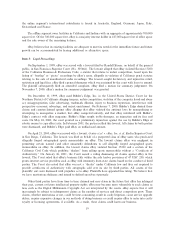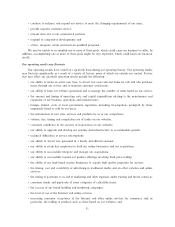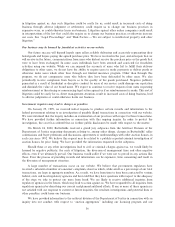eBay 2000 Annual Report Download - page 34
Download and view the complete annual report
Please find page 34 of the 2000 eBay annual report below. You can navigate through the pages in the report by either clicking on the pages listed below, or by using the keyword search tool below to find specific information within the annual report.Liquidity and Capital Resources
Since inception, eBay has Ñnanced operations primarily from net cash generated from operating activities.
We obtained additional Ñnancing from the sale of preferred stock and warrants, proceeds from the exercise of
those warrants, proceeds from the exercise of stock options, and proceeds from our initial and follow-on public
oÅerings.
Net cash provided by operating activities was $6.0 million in 1998, $62.9 million in 1999 and
$100.1 million in 2000. Net cash provided by operating activities resulted primarily from our net income
before non-cash charges for depreciation and amortization, and changes in accrued expenses oÅset by changes
in accounts receivable and other assets.
Net cash used in investing activities was $53.0 million in 1998, $603.4 million in 1999, and $206.1 million
in 2000. The primary use for invested cash in the periods presented was purchases of investments, property,
and equipment.
Net cash provided by Ñnancing activities was $72.2 million in 1998, $725.0 million in 1999, and
$86.0 million in 2000. We remained cash Öow positive from Ñnancing activities primarily due to our public
oÅering in 1998 and our subsequent follow-on oÅering in 1999. To a lesser extent, Ñnancing activities included
the sale of common stock under employee beneÑt plans. In 2000, net cash provided by Ñnancing activities
primarily resulted from the issuance of common stock to third parties by our subsidiaries.
We had no material commitments for capital expenditures at December 31, 2000, but expect such
expenditures to approximate $86.0 million during 2001 without taking into account any acquisitions. Of the
$86.0 million, approximately $20.0 million has been committed for capital expenditures relating to hardware
and software for the development of our new architecture. The remaining balance will be used primarily for
computer equipment, furniture and Ñxtures and leasehold improvements. We also have total minimum lease
obligations of $43.9 million under certain noncancellable operating leases and notes payable obligations of
$26.7 million through August 2023. Under our agreement with AOL, we will pay AOL $75 million over the
four-year term of the contract. To date, we have paid $37.5 million on the contract. In February 2000, we
signed an agreement with GO.com. In consideration for this agreement, we will pay a minimum of $30 million
to GO.com over the four-year term. In 2001, Disney announced that it was dissolving GO.com; consequently,
eBay is currently in the process of renegotiating new contract terms with Disney.
We believe that existing cash, cash equivalents and investments, and any cash generated from operations
will be suÇcient to fund our operating activities, capital expenditures and other obligations for the foreseeable
future. However, if during that period or thereafter we are not successful in generating suÇcient cash Öow
from operations or in raising additional capital when required in suÇcient amounts and on terms acceptable to
us, our business could suÅer.
Recent accounting pronouncements
In June 1998, the Financial Accounting Standards Board (""FASB'') issued SFAS No. 133, ""Accounting
for Derivatives and Hedging Activities.'' SFAS No. 133 establishes accounting and reporting standards for
derivative instruments, including certain derivative instruments embedded in other contracts, and for hedging
activities. In June 1999, the FASB issued SFAS No. 137, ""Accounting for Derivative Instruments and
Hedging Activities Ì Deferral of the EÅective Date of FASB Statement No. 133,'' which deferred the
eÅective date until the Ñrst Ñscal year ending on or after June 30, 2000. In June 2000, the FASB issued SFAS
Statement No. 138, ""Accounting for Certain Derivative Instruments and Certain Hedging Activities-an
Amendment of SFAS 133.'' SFAS No. 138 amends certain terms and conditions of SFAS 133. SFAS 133
requires that all derivative instruments be recognized at fair value as either assets or liabilities in the statement
of Ñnancial position. The accounting for changes in the fair value (i.e., gains or losses) of a derivative
instrument depends on whether it has been designated and qualiÑes as part of a hedging relationship and
further, on the type of hedging relationship. We will adopt SFAS No. 133, as amended, in our quarter ending
March 31, 2001. Upon adoption, the cumulative eÅect to net income and other comprehensive income of this
29
























